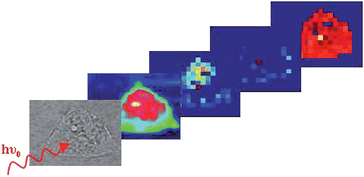Raman spectral imaging of single living cancer cells: a preliminary study
Abstract

* Corresponding authors
a
Unité MéDIAN, Université de Reims Champagne-Ardenne, CNRS UMR 6237, UFR de Pharmacie, IFR53, 51 rue Cognacq-Jay, 51096 Reims Cedex, France
E-mail:
ganesh.sockalingum@univ-reims.fr
Fax: +33 326913550
Tel: +33 326913553
b Staffordshire Oncology Centre, University Hospital of North Staffordshire and Keele University, Stoke on Trent, UK

 Please wait while we load your content...
Something went wrong. Try again?
Please wait while we load your content...
Something went wrong. Try again?
F. Draux, P. Jeannesson, A. Beljebbar, A. Tfayli, N. Fourre, M. Manfait, J. Sulé-Suso and G. D. Sockalingum, Analyst, 2009, 134, 542 DOI: 10.1039/B812610K
To request permission to reproduce material from this article, please go to the Copyright Clearance Center request page.
If you are an author contributing to an RSC publication, you do not need to request permission provided correct acknowledgement is given.
If you are the author of this article, you do not need to request permission to reproduce figures and diagrams provided correct acknowledgement is given. If you want to reproduce the whole article in a third-party publication (excluding your thesis/dissertation for which permission is not required) please go to the Copyright Clearance Center request page.
Read more about how to correctly acknowledge RSC content.
 Fetching data from CrossRef.
Fetching data from CrossRef.
This may take some time to load.
Loading related content
